Black and red snakes are terrestrial, aquatic, or semi-aquatic. These snakes can be venomous, mildly venomous, or non-venomous.
Common snakes such as the Ring-necked snake are known for being black and red. Even venomous snakes such as the Texas Coralsnake or the Eastern Coralsnake are known to come with black and red coloring.
Snakes such as the Ring-necked snake are known to be only black and red. Other snakes such as coral snakes have red and black coloring alongside a third color such as yellow.
Red and black coloring in adult snakes can be different from the coloring of young snakes. This is why the following red and black snakes are all red and black as adults.
Table of Contents
Are black and red snakes venomous?
Snake venom isn’t influenced by black and red coloring. As a result, most red and black snakes aren’t venomous even if venomous species exist.
Venomous
Venomous red and black snakes are not easy to find in the US and deaths following their bites are scarce.
Medical attention is required following a venomous red and black snake bite.
But this can be a dry bite even in the case of venomous species. Antivenin might be given to those bitten by venomous red and black snakes.
Non-venomous
Black and red snakes are mostly non-venomous. They might still bite, but their bite does not cause severe health reactions in humans.
Most red and black snakes eat spiders, insects, scorpions, earthworms, or even other snakes. They aren’t interested in biting people and they might even decide to flee or play dead when seeing humans.
Types of Black and Red Snakes
The following species of snakes are only red and black or dominantly red and black. They can be venomous or non-venomous.
1. Ring-necked Snake

Scientific name: Diadophis punctatus
Common name: Ring-necked snake, ringneck snake
The Ring-necked snake is known for its black dorsal coloring and red or orange ventral coloring.
Ring-necked snakes are bicolored species that are common in the US, particularly in Southern states.
Snakes of this genus live in a wide range of habitats and including woodlands where they find leaves to crawl through and specific prey that needs moisture to feed on such as salamander.
These common snakes are rather small. They grow to a maximum size between 10 and 15 inches resembling fossorial snakes in body size.
Ring-necked snakes might be small but they have venomous saliva. This saliva isn’t venomous to people.
The saliva of these snakes is used to subdue various prey which includes salamander and earthworms.
2. Red-bellied Snake

Scientific name: Storeria occipitomaculata
Common name: Red-bellied snake, redbelly snake
Similar to Ring-necked snakes, red-bellied snakes have a similar bicolored appearance.
They have a dark gray dorsal and a red underbelly.
Snakes of the genus are small. They can be as small as 4 inches as adults with some of the largest members of the species growing up to 10 inches.
Found in woodlands and on the edge of wetlands, these snakes only feed on slugs, which are very common in these habitats.
Reproductive rates can be high as mature females give birth to live snakes each summer.
Up to 23 live young snakes are born each summer.
However, most females only give birth to around 9 live snakes when not raised in captivity.
3. Texas Coralsnake

Scientific name: Micrurus tener
Common name: Texas coralsnake
This multicolored snake is known for its black, red, and yellow rings.
It’s one of the most venomous snakes in Southern states and it’s seen as dangerous to prey and people.
Multiple other snake species look similar to the Texas Coralsnake, mainly by having similar colors in a mimicking trait.
This species feeds on other snakes, mainly on smaller snakes.
Its venom is used to subdue other snakes quickly.
The venom of the Texas Coralsnake is also dangerous to humans.
Reported deaths are very rare but this snake used to kill up to 10% of bitten people.
The antivenin specifically made against the venom of the Texas Coralsnake has ceased production.
Neuromuscular dysfunction is one of the main side effects of its potent venom.
All people bitten by this snake should immediately seek medical attention.
However, not all bites of the species are venomous.
While people should seek medical attention following a Texas Coralsnake bite, some of these bites are dry bites.
No venom is inserted with these bites as the snake preserves it for other occasions.
4. Ground Snake

Scientific name: Sonora semiannulata
Common name: Ground snake, western ground snake, common ground snake, variable ground snake, miter snake
The Ground snake is one of the species that also come in black and red coloration.
Snakes of this genus are often seen in many other colors.
Color variations in Ground snakes include orange and black, brown and black, or red and black.
Snakes of this genus grow up to 18 inches.
They aren’t easily seen by people as they’re most common in rocky areas with loose soil where they can easily move through and stay warm.
Ground snakes are nocturnal. Al sightings are at night when the snake comes out for food.
It can sometimes be found in the drainage system of the house as it looks for rodents, roaches, and moisture.
Spiders are often attracted to this species which is why it may wonder in suburban areas next to homes at times.
5. Mudsnake

Scientific name: Farancia abacura
Common name: Mudsnake
Mudsnakes are some of the most common but secretive black and red snakes. This genus is known to live in wetlands in the Southern US.
Mudsnakes change coloring as they mature.
They can be yellow and black or red, yellow, and black as young snakes and red and black as mature snakes.
The diet of the species is varied and tied to different aquatic vertebrates and invertebrates.
Giant salamanders are often consumed by this snake.
Mudsnakes aren’t venomous as many other aquatic snakes.
They are protected in some states such as Georgia due to diminishing aquatic habitat.
Mudsnakes are rarely seen. Sightings are at night when this snake might be moving towards another wetland area.
6. Eastern Coralsnake

Scientific name: Micrurus fulvius
Common name: Eastern coralsnake, common coral snake, American cobra, candy-stick snake, coral adder, Elaps harlequin snake, Florida coral snake, harlequin coral snake, North American coral snake, red bead snake, thunder-and-lightning snake
The Eastern Coralsnake resembles the Texas Coralsnake.
Snakes of this species have a slender red, black, and yellow body. It’s known for the colored rings around its slender body.
Eastern Coralsnakes grow to a size of up to 4 feet.
This is a species that lives in Southern states where it finds woodlands or sandy terrains such as the plains of Florida.
Eastern Coralsnakes are highly venomous but bites are rare.
Severe reactions are common following a venomous bite of this red and black snake.
Double vision and an inability to speak are common symptoms of the Eastern Coralsnake bite.
However, these snakes don’t seek to bite.
They are mostly interested in their usual diet which is comprised of lizards and other smaller snakes.
7. Western Worm Snake

Scientific name: Carphophis vermis
Common name: Western worm snake
Western Worm snakes are bicolored species.
These snakes have a black dorsal and a red underbelly.
Western Worm snakes are a small species. Most adults grow to a maximum length of 11 inches.
Like other small slender snakes, the Western Worm snake is fossorial, spending most of its life underground.
Snakes of this genus are rather secretive given they live underground.
They are mostly interested in coming out and seeking earthworms to eat.
Female Western Worm snakes are known for laying eggs at the end of spring.
Up to 8 eggs are laid at a time by the female Western Worm snake which emerges as miniature adults in early fall.
8. Gray-banded Kingsnake
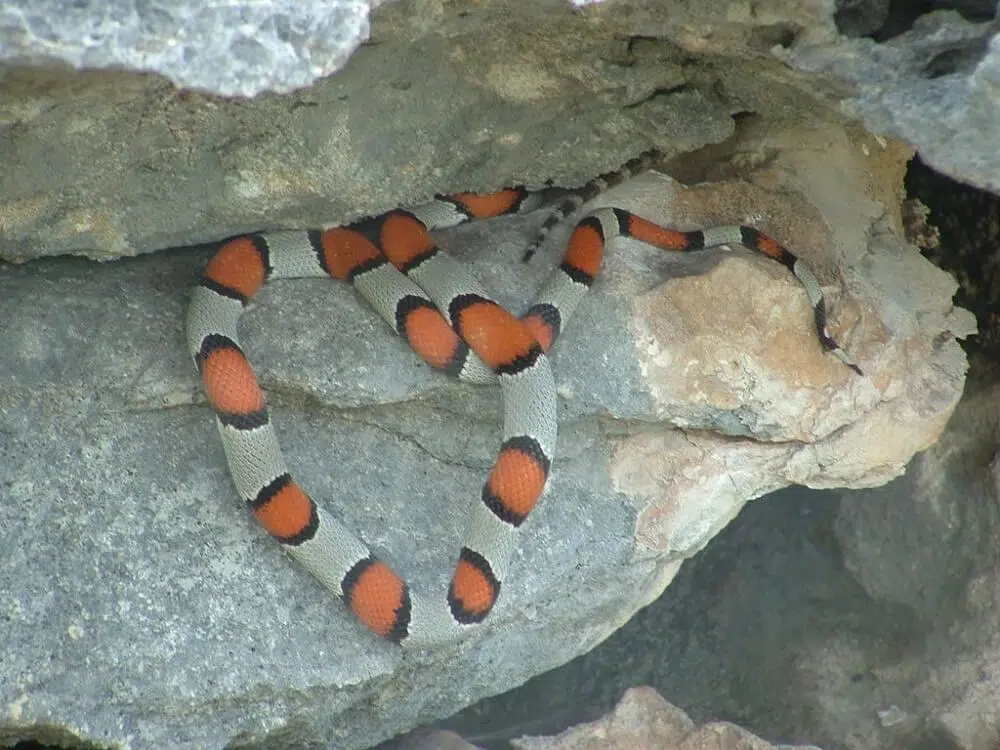
Scientific name: Lampropeltis alterna
Common name: Gray-banded kingsnake, Davis Mountain king snake
The Gray-banded Kingsnake comes in 2 morphs. This species has red-orange or orange-red bands with a gray or a black background color.
This snake species might be common in high numbers but it’s not common in human-populated areas which makes it a rare sight.
Gray-banded Kingsnakes live on rocky terrains, particularly on limestone. They live high up mountain slopes where people can rarely see them.
Furthermore, this species is nocturnal so the chances of seeing one are even smaller.
Gray-banded Kingsnakes come out looking for food at night. Snakes of this genus eat lizards, frogs, and various eggs.
Snakes of this genus lay up to 13 eggs in the summer which hatches within 2-3 months.
Living in Southwestern US, the Gray-banded Kingsnake might not be easy to find in its habitat but it’s a common sight in the snake pet trade.
9. Sonoran Coralsnake

Scientific name: Micruroides euryxanthus
Common name: sonoran coralsnake, Western Coral Snake, Arizona coral snake
Sonoran Coralsnakes are also known as Western Coralsnakes. This species is common in Central Arizona and parts of New Mexico.
It has red and black rings that go around its body together with off-white to white rings that cover its body that grows up to 21 inches.
Sonoran Coralsnakes are highly venomous. These snakes can inflict a lot of pain, necrosis, fever, vomiting, nausea, blurred vision, and other side effects.
While its venom isn’t fatal, it still requires medical attention.
Sonoran Coralsnakes prefer not to engage with people whenever they can make a quick escape.
Snakes of this type are also known for releasing a foul smell that helps them keep certain predators away.
The Sonoran Coralsnake eats lizards and other similar creatures it finds in its arid climate.
10. Black Swampsnake
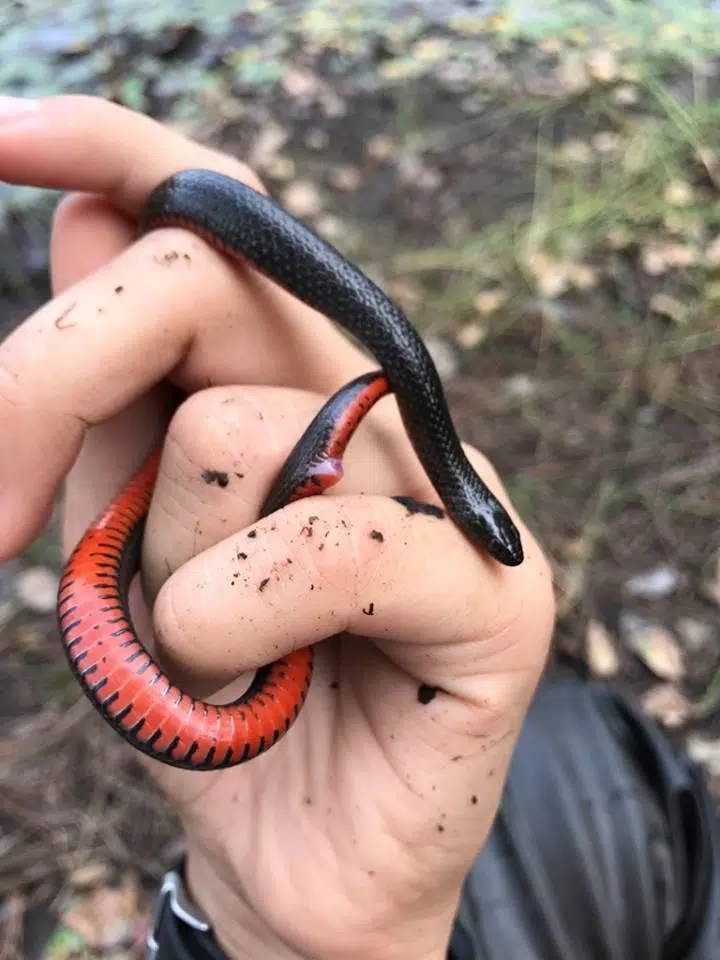
Scientific name: Liodytes pygaea
Common name: Black swampsnake, mud snake, red-bellied mud snake, swamp snake
The black and red Black Swampsnake only live in semiaquatic environments such as swamps.
Snakes of this genus are the most common in Florida due to the large number of swamps in the state.
As nocturnal species, the Black Swampsnake isn’t seen too often.
Black Swampsnakes grow to a size of up to 15 inches.
They eat small fish living in swamps, small frogs, and earthworms.
Black Swampsnakes swallow small prey immediately.
Snakes of this genus are non-venomous and not aggressive. They try to flee when seeing people.
A foul smell is immediately released by this snake in the face of adversity.
11. Thornscrub Hook-nosed Snake

Scientific name: Gyalopion quadrangulare
Common name: Thornscrub hook-nosed snake
This snake species is known for its red underbelly with black, and gray banding.
Living in New Mexico and Arizona, the snake is also known for its upturned snout.
Snakes of this genus are found in grassland and short grass prairies.
Seeing a snake of this family is a rare occurrence as it’s only active at night, preferring to hide in vegetation during the day.
Spiders are among its preferred food together with centipedes.
Snakes of this genus are known as oviparous. This means they lay clusters of eggs that hatch anywhere between 9 and 12 weeks.
12. Banded Watersnake
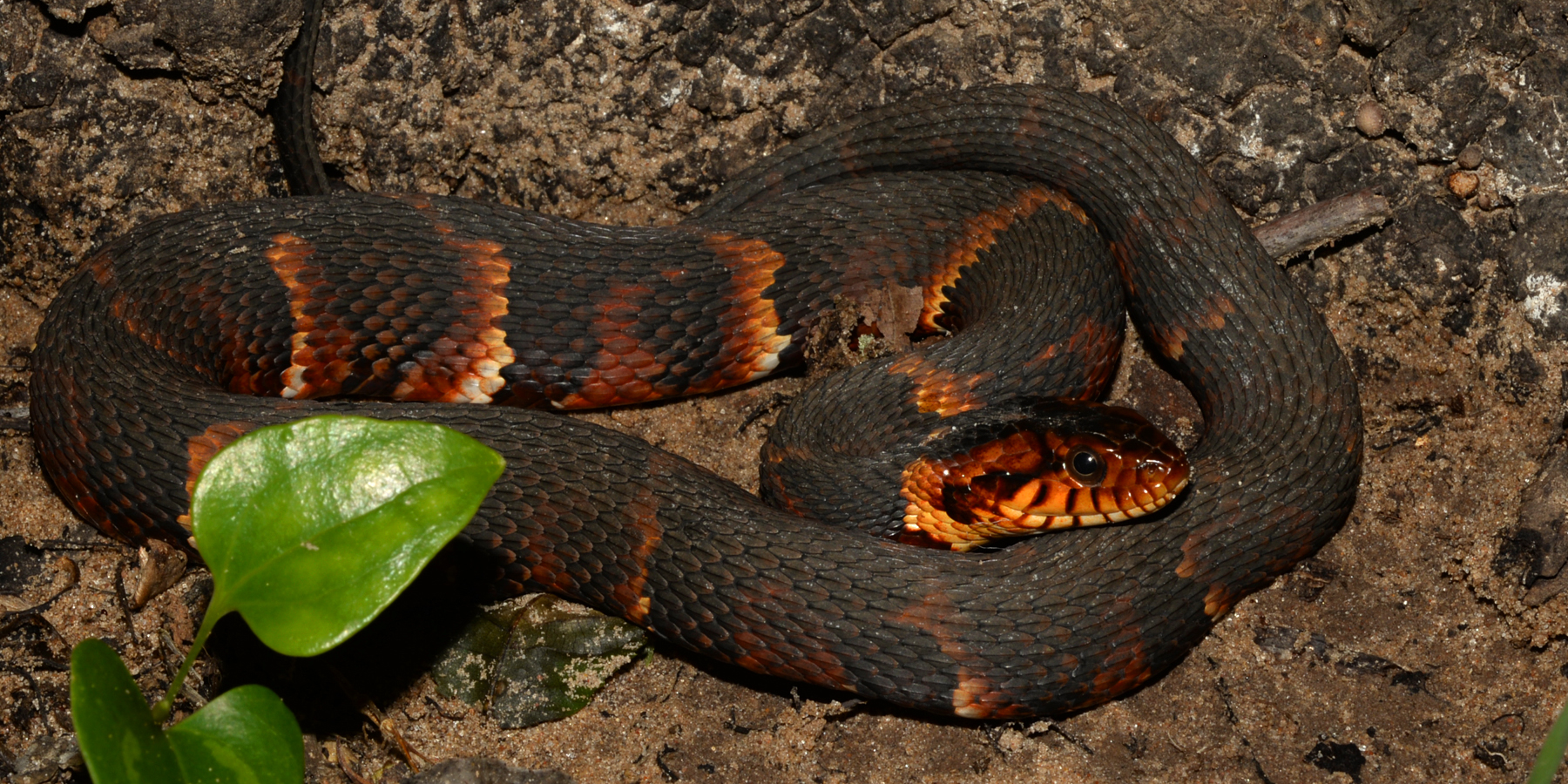
Scientific name: Nerodia fasciata
Common name: Banded watersnake, southern water snake
Banded Watersnakes come in multiple morphs. They can be brown, gray, or black and red.
Snakes of this genus grow to a size between 24 and 48 inches.
Found in coastal plans such as Florida, this species is also known as the Florida Watersnake.
Snakes of this genus are commonly seen since they are diurnal and nocturnal.
High activity levels make this snake one of the most common watersnakes.
Florida watersnakes can often be seen basking in the sun.
Snakes of this genus give birth to live young snakes at the end of the summer.
The species is protected in some areas of the US.
13. Eastern Hognose Snake

Scientific name: Heterodon platirhinos
Common name: Eastern hognose snake, eastern hog-nosed snake, spreading adder, spread’em outer, hog-nosed snake, adder.
Eastern Hognose snakes come in multiple colors. One of the morphs of the species comes with orange-red and black.
The snake is dominated by an orange-red color with a few black patches from head to tail.
Common in Eastern US, this species is confirmed by its thick body and size which reaches up to 46 inches.
Eastern Hognose snakes are known for having multiple defensive techniques which make them a unique species.
For example, it bloats its neck similar to a cobra to appear fearsome.
The Eastern Hognose snake can also play dead. It goes as far as sticking its tongue out and staying motionless to appear dead and to potentially deter predators.
These snakes are also known for eating salamander, toads, small birds, and other small mammals.
Eastern Hognose snakes are some of the most resilient species when it comes to surviving potentially poisonous prey.
They can eat toads that are poisonous to other predators.
Eastern Hognose snakes swallow live toads.
14. Eastern Worm Snake

Scientific name: Carphophis amoenus
Common name: Eastern worm snake
Eastern Worm Snakes are burrowers that come in many morphs. They are also found in a black and red morph where red is the color of the underbelly.
Bicolored snakes of this genus are a rare sight due to their burrowing nature. They spend most of their lives underground, even if just under the surface.
Some of these snakes are found hiding in rotting logs as they come out still seeking a humid place to live in.
Eastern Worm snakes live for a few years. However, they tend to become inactive to conserve energy in extreme temperatures.
The snake is inactive during the winter and the very hot summer days.
Eastern Worm snakes live in forests with thick canopies. They are sometimes predated by other species such as opossums due to their small slender bodies.
Snakes of the genus are also known for traveling very short distances of just a few yards per day.
They use their heads to burrow and make their way through the ground looking for earthworms.
Eastern Worm snakes begin to become active in the afternoon, just as daytime temperatures start to drop.
Snakes of this genus remain active in the first part of the night being both diurnal and nocturnal.
These snakes are mainly found in woodlands. They can also be found at the edge of woodlands.
Eastern Worm snakes can also be found in grassland, but they don’t have the largest populations outside their preferred woodlands habitats.
Eastern Worm Snakes are very common to the extent of being the most common species in states such as Northern Virginia.
15. Pygmy Rattlesnake

Scientific name: Sistrurus miliarius
Common name: Pygmy rattlesnake, Eastern pygmy rattlesnake, ground rattlesnake, leaf rattler, death rattler, hog-nosed rattlesnake, little rattlesnake, miliar(y) rattlesnake, North American smaller rattlesnake, oak-leaf rattler
Pygmy Rattlesnakes come in different morphs. This includes a red and black morph, that’s not too common compared to the gray or lavender morph of the species.
This morph is venomous, just as all other morphs of the Pygmy Rattlesnake.
The species is known for inhabiting creeks and marshes even if it can be seen in dryer land as well.
It likes to live in thick vegetation and in mixed forests where it finds a wide range of lizards it normally feeds on.
Frogs are also consumed by the species.
In the absence of larger prey, Pygmy Rattlesnakes are also known for going after insects and arachnids.
Seeing one of these black and red snakes is considered difficult as the species spend most of its time hiding.
Snakes of this genus use leaves, bushes, and rocks as hiding places as ambushing are their main hunting technique.
Some Pygmy Rattlesnakes might be seen at night when they cross public roads in the vicinity of creeks, marshes, and woodlands.
These snakes are mostly seen in their natural habitat as they don’t venture outside their preferred range.
Some Pygmy Rattlesnakes are found in the burrows of other species, mainly using these burrows as hiding places.
The burrows of turtles and rats are used as hiding places by Pygmy Rattlesnakes.
16. Central American Indigo Snake
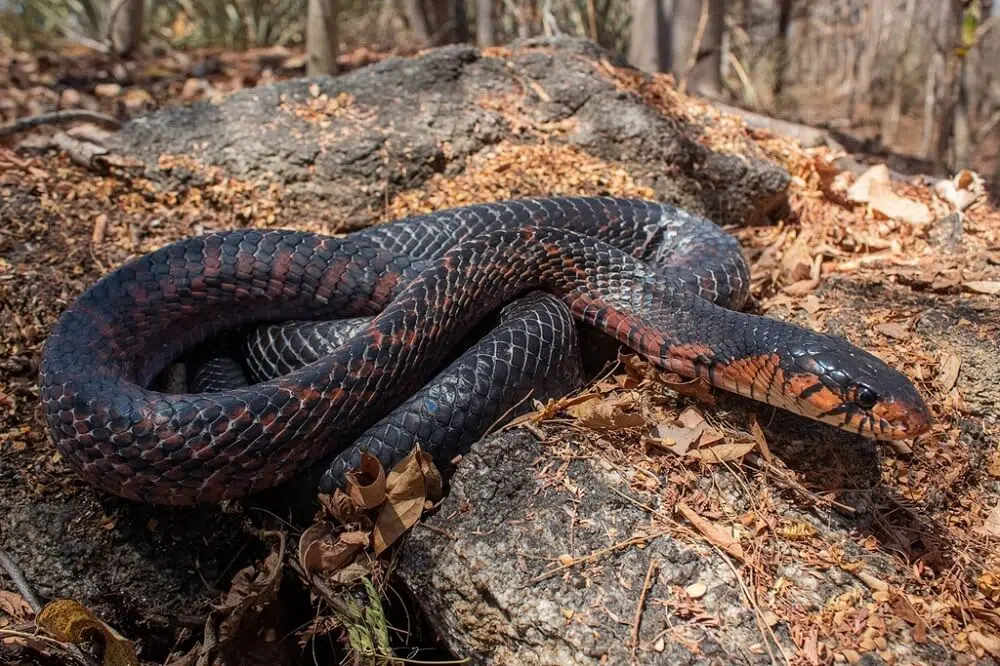
Scientific name: Drymarchon melanurus
Common name: Central American indigo snake, middle American indigo snake, blacktail cribo
The black and red morph of the Central American Indigo snake is one of the most important species in this color.
While there are other snakes with a black dorsal and a red underbelly these are mostly earth snakes or small snakes that live underground.
The Central American Indigo snake isn’t small. It grows up to 6 feet.
This makes it one of the largest black and red snakes in the world.
It comes with glossy scales which are mostly black on the dorsal and mostly red on the underside.
The top of its head is black while the bottom side of its head is red.
The species is native to Southern US and Central America. Most people know it by its olive green morph.
Snakes of this morph are rare in the Southern US.
The black and red morph is very common in Northern, Central, and Southern Mexico.
Black and red Central American Indigo snakes are also seen in Honduras, Peru, Colombia, and Ecuador.
17. Rainbow Snake

Scientific name: Farancia erytrogramma
Common name: Rainbow snake, eel moccasin, horn snake, red-lined snake, red-lined horned snake, red-sided snake, sand hog, sand snake, and striped wampum
Rainbow snakes are some of the most common black and red snakes in the Southern US.
Snakes of this genus live in cypress swamps as well as in other aquatic environments.
They are known for being multicolored and this inspires their name.
The underbelly of the species is mostly red, which gives the name of this snake species.
However, the underbelly also has black and yellow lines which make it a bit more distinct and a species that’s easy to identify.
Known as Eel snakes in Florida, these snakes are sometimes seen eating eel.
They remain highly secretive and they can’t be seen even by dedicated snake enthusiasts and researchers even if their numbers are high.
Their secretive lives are mostly tied to living in wetlands with very thick vegetation which is seen in places people rarely visit.
These snakes lay more than 20 eggs per season and they can be seen laying up to 50 eggs in a proficient mating season.
18. Tamaulipan Milksnake

Scientific name: Lampropeltis annulata
Common name: Tamaulipan milksnake, Mexican milk snake
This species is common in the US and Canada. It’s characterized by a red body with alternating black and yellow bands.
Milksnakes are mostly red but the intensity of the color can vary according to the region they live in.
Some of these milksnakes have a vivid red color while others have red-brown coloring.
Snakes of the genus are very secretive as they prefer to flee whenever they see people. They can even climb to escape.
However, they remain docile when handled and this makes them some of the most commonly red and black exotic pet snakes.
Snakes of this genus only become aggressive when threatened.
They might try to vibrate their tails as a warning sign before biting.
A bite occurs soon after they vibrate their tails when threatened.
These snakes are non-venomous and they prefer not to bite. They even move slowly to avoid all types of confrontations.
These terrestrial snakes look slightly different from juveniles.
While is the dominant color instead of red and the black coloring is considerably reduced in juveniles.
Snakes of this genus are known for having a wide diet, specific to terrestrial non-venomous snakes.
They eat all types of insects and spiders.
These milksnakes also eat rodents, reptiles, birds, and various eggs.
Reproductive rates are smaller in the species compared to other terrestrial snakes. Up to 10 eggs can be laid at a time by a female Tamaulipan Milksnake.
19. Sharp-tailed Snake
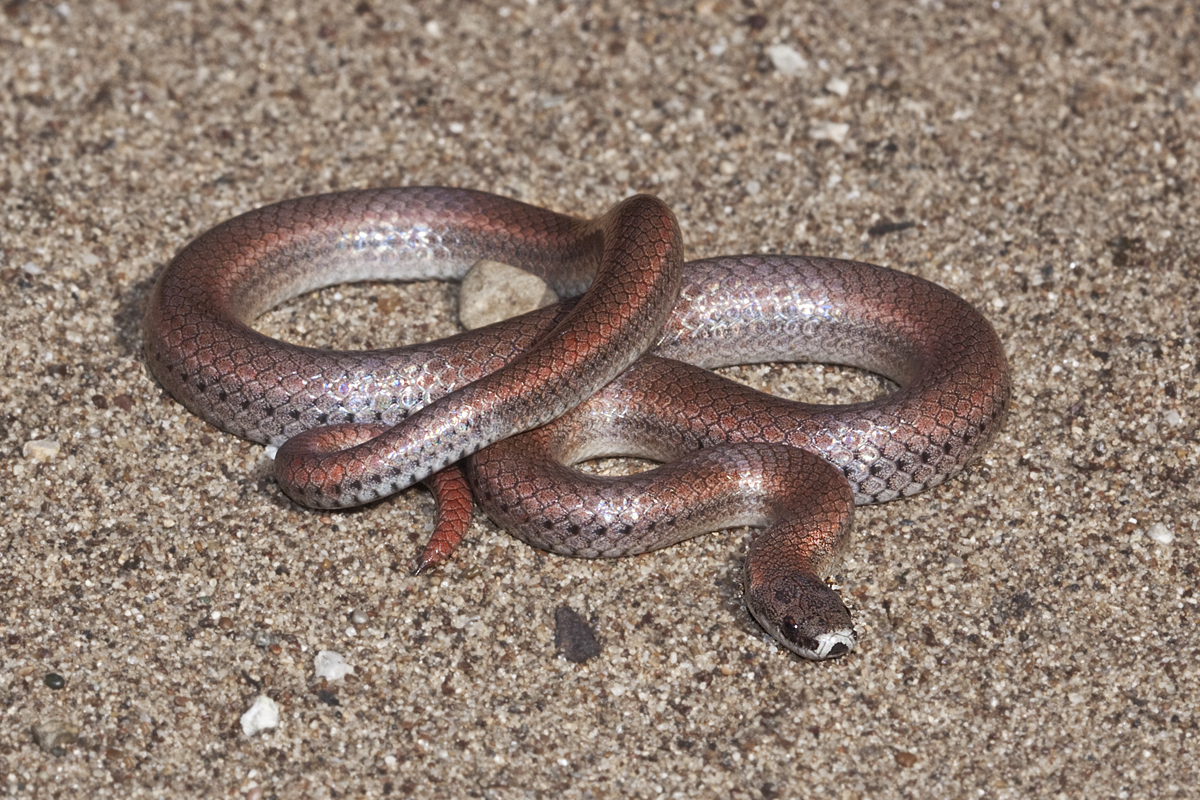
Scientific name: Contia tenuis
Common name: Sharp-tailed snake, sharptail snake, brown snake, gentle brown snake, Oregon worm snake, Pacific brown snake, Pacific ground snake, and purple-tailed snake
The Sharp-tailed Snake is native to the Western US. It’s a burrowing species that has black and red coloring.
Its black coloring can be a dark gray morph in certain areas.
Snakes of this genus are mostly found when doing construction work and digging up the ground.
They are unearthed and often confused with worms as they only measure a few inches and have similar slender bodies earthworms have.
These burrowing snakes are found all over Oregon which is why they’re often known as the Oregon worm snake.
However, the species is also present in other Western territories further North such as British Colombia.
Sharp-tailed snakes get their names from the pointy tails they use to poke prey with, typically slugs.
These snakes tend to become defensive and motionless when unearthed.
They curl up in a ball and remain motionless for a few minutes.
Rarely found in open land, the Sharp-tailed Snake is one of the species that might be found under logs, especially under moist rotting logs.
Snakes of this genus live secretive lives and knowing exactly how many eggs they lay isn’t possible.
They are known for laying anywhere between 4 and 16 eggs in the summer.
Most eggs are laid underground which means they’re never seen. Alternatively, these snakes can lay eggs in the burrows of various rodents.
It takes up to a few weeks for the eggs to hatch.
Newly emerged snakes are similar to black and red adults. They only measure around 4 inches.
Further Reading: